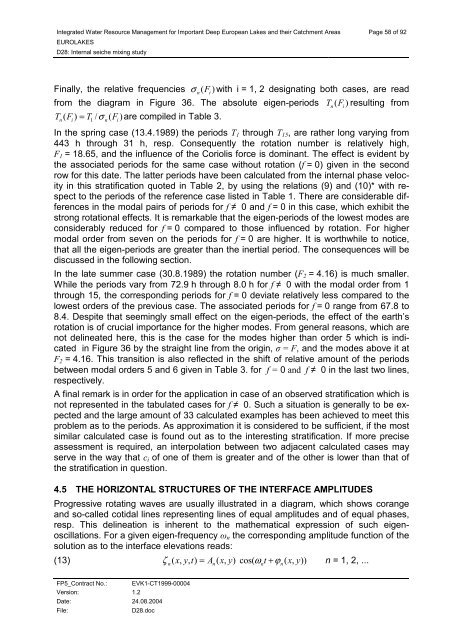D28: Internal seiche mixing study - Hydromod
D28: Internal seiche mixing study - Hydromod
D28: Internal seiche mixing study - Hydromod
You also want an ePaper? Increase the reach of your titles
YUMPU automatically turns print PDFs into web optimized ePapers that Google loves.
Integrated Water Resource Management for Important Deep European Lakes and their Catchment Areas<br />
EUROLAKES<br />
<strong>D28</strong>: <strong>Internal</strong> <strong>seiche</strong> <strong>mixing</strong> <strong>study</strong><br />
FP5_Contract No.: EVK1-CT1999-00004<br />
Version: 1.2<br />
Date: 24.08.2004<br />
File: <strong>D28</strong>.doc<br />
Page 58 of 92<br />
Finally, the relative frequencies σ ( i ) with i = 1, 2 designating both cases, are read<br />
from the diagram in Figure 36. The absolute eigen-periods T ) resulting from<br />
n F<br />
T F ) = T / σ ( F ) are compiled in Table 3.<br />
n(<br />
i 1 n i<br />
In the spring case (13.4.1989) the periods T1 through T15, are rather long varying from<br />
443 h through 31 h, resp. Consequently the rotation number is relatively high,<br />
F1 = 18.65, and the influence of the Coriolis force is dominant. The effect is evident by<br />
the associated periods for the same case without rotation (f = 0) given in the second<br />
row for this date. The latter periods have been calculated from the internal phase velocity<br />
in this stratification quoted in Table 2, by using the relations (9) and (10)* with respect<br />
to the periods of the reference case listed in Table 1. There are considerable differences<br />
in the modal pairs of periods for f ≠ 0 and f = 0 in this case, which exhibit the<br />
strong rotational effects. It is remarkable that the eigen-periods of the lowest modes are<br />
considerably reduced for f = 0 compared to those influenced by rotation. For higher<br />
modal order from seven on the periods for f = 0 are higher. It is worthwhile to notice,<br />
that all the eigen-periods are greater than the inertial period. The consequences will be<br />
discussed in the following section.<br />
In the late summer case (30.8.1989) the rotation number (F2 = 4.16) is much smaller.<br />
While the periods vary from 72.9 h through 8.0 h for f ≠ 0 with the modal order from 1<br />
through 15, the corresponding periods for f = 0 deviate relatively less compared to the<br />
lowest orders of the previous case. The associated periods for f = 0 range from 67.8 to<br />
8.4. Despite that seemingly small effect on the eigen-periods, the effect of the earth’s<br />
rotation is of crucial importance for the higher modes. From general reasons, which are<br />
not delineated here, this is the case for the modes higher than order 5 which is indicated<br />
in Figure 36 by the straight line from the origin, σ = F, and the modes above it at<br />
F2 = 4.16. This transition is also reflected in the shift of relative amount of the periods<br />
between modal orders 5 and 6 given in Table 3. for f = 0 and f ≠ 0 in the last two lines,<br />
respectively.<br />
A final remark is in order for the application in case of an observed stratification which is<br />
not represented in the tabulated cases for f ≠ 0. Such a situation is generally to be expected<br />
and the large amount of 33 calculated examples has been achieved to meet this<br />
problem as to the periods. As approximation it is considered to be sufficient, if the most<br />
similar calculated case is found out as to the interesting stratification. If more precise<br />
assessment is required, an interpolation between two adjacent calculated cases may<br />
serve in the way that ci of one of them is greater and of the other is lower than that of<br />
the stratification in question.<br />
4.5 THE HORIZONTAL STRUCTURES OF THE INTERFACE AMPLITUDES<br />
Progressive rotating waves are usually illustrated in a diagram, which shows corange<br />
and so-called cotidal lines representing lines of equal amplitudes and of equal phases,<br />
resp. This delineation is inherent to the mathematical expression of such eigenoscillations.<br />
For a given eigen-frequency ωn the corresponding amplitude function of the<br />
solution as to the interface elevations reads:<br />
(13) ζ ( , y,<br />
t)<br />
= A ( x,<br />
y)<br />
cos( ω t + ϕ ( x,<br />
y))<br />
n = 1, 2, ...<br />
n x n<br />
n n<br />
n( Fi









